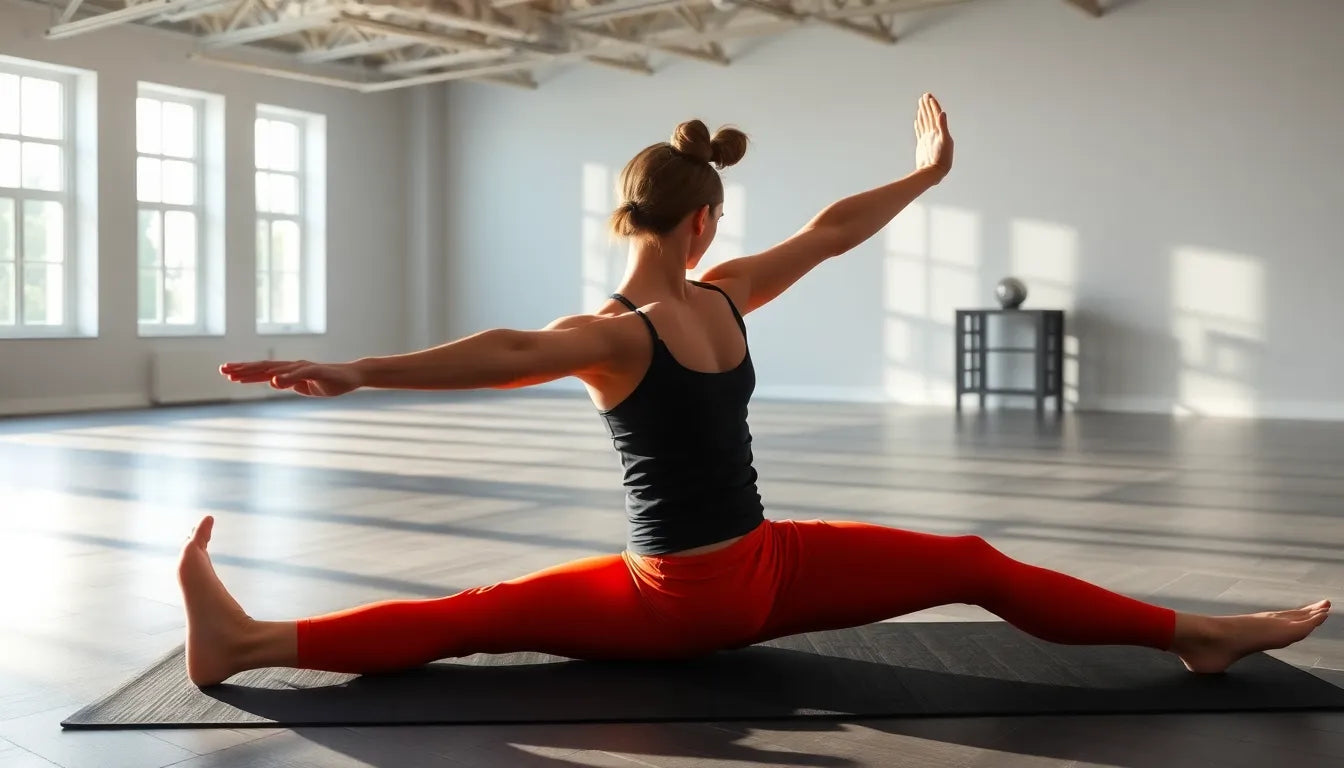Understanding the importance of knee flexibility is essential for maintaining overall mobility and preventing injuries. Our knees play a crucial role in daily activities, from walking and running to bending and lifting. However, when knee flexibility is compromised, it can lead to a range of issues, including a reduced range of motion, discomfort, and an increased risk of injury. Knee stiffness often arises from factors such as aging, injury, or conditions like arthritis, making it difficult to perform even simple tasks.
Stretching exercises specifically designed for the knees are vital in enhancing flexibility, especially after an injury or for individuals dealing with arthritis. These exercises not only help in regaining lost mobility but also in maintaining the health of the knee joint over time. By incorporating regular stretching into your routine, you can significantly improve your knee's range of motion and reduce the likelihood of future problems.
The goal of knee stretching exercises
The primary objectives of knee stretching exercises are to improve flexibility, reduce pain, and prevent future knee problems. By focusing on these goals, individuals can enhance their overall quality of life and maintain an active lifestyle. Knee stretching exercises are particularly beneficial for a wide range of people, including athletes who require optimal joint function for performance, elderly individuals who may experience natural stiffness due to aging, and those recovering from knee injuries who need to restore their range of motion.
For athletes, maintaining knee flexibility is crucial for performance and injury prevention. Regular stretching can help prevent strains and sprains that often occur during physical activities. Similarly, elderly individuals can benefit from these exercises as they help in maintaining independence and reducing the risk of falls. For those recovering from knee injuries, stretching exercises are an integral part of rehabilitation, aiding in the healing process and ensuring that the joint regains its full functionality.
Incorporating knee stretching exercises into your routine is a proactive approach to safeguarding your knee health. By doing so, you can enjoy improved mobility, reduced pain, and a lower risk of injury, allowing you to engage in your favorite activities with confidence and ease.
In-depth information and exercises for knee flexibility
To effectively enhance knee flexibility, it's essential to incorporate a diverse range of stretching exercises that target various muscle groups in the leg. By focusing on the hamstrings, quadriceps, and hip flexors, you can support the overall flexibility and function of the knee joint. Additionally, using supportive tools like towels and foam rollers can significantly enhance the effectiveness of these stretches, allowing for deeper and more controlled movements.
Overview of key stretching techniques
Incorporating a variety of stretching techniques into your routine is crucial for comprehensive knee flexibility. These stretches not only target the muscles surrounding the knee but also contribute to the health and mobility of the entire leg. By regularly practicing these exercises, you can alleviate tension, improve your range of motion, and reduce the risk of injury. Below is a list of effective stretching exercises that can be easily performed at home.
Exercise list
Seated hamstring stretch
Instructions: Sit on the floor with one leg extended and the other bent. Lean forward from the hips, reaching toward the toes of the extended leg, and hold the stretch for 20-30 seconds.
Benefits: This exercise stretches the back of the thigh and the area behind the knee, improving flexibility and reducing tension, which is essential for maintaining knee health.
Supported knee extension stretch
Instructions: Place a towel under your heel while sitting with your leg extended. Allow gravity to assist in gently extending the knee further, holding for 15-20 seconds.
Benefits: This stretch enhances knee extension and flexibility without causing discomfort, making it ideal for those recovering from injuries or dealing with arthritis.
Quad stretch with support
Instructions: Stand near a wall or chair for balance. Bend one knee, bringing the heel towards the buttocks, and grasp the ankle with your hand to stretch the quadriceps. Hold for 20-30 seconds.
Benefits: Stretching the front of the thigh is crucial for knee support and mobility, helping to prevent injuries and improve range of motion.
Hip flexor and quadriceps stretch
Instructions: In a lunge position, lower your hips towards the floor. Keep the back leg straight to feel a stretch in the hip flexor and quadriceps. Hold for 20-30 seconds on each side.
Benefits: This exercise improves flexibility in the hip flexors and quadriceps, which is vital for overall knee function and reducing strain on the joint.
Foam roller stretch for IT band and hip
Instructions: Lie on your side with a foam roller under your hip. Roll slowly from hip to knee, focusing on tight areas. Spend 1-2 minutes on each side.
Benefits: This technique releases tension in the IT band, which can impact knee alignment and flexibility, ultimately supporting better knee health.
By incorporating these stretching exercises into your routine, you can significantly enhance your knee flexibility and overall leg function. These exercises are not only beneficial for those recovering from injuries but also for anyone looking to maintain healthy and mobile knees. Remember, consistency is key, and combining these stretches with strengthening exercises can further improve stability and support for the knees.
Combining stretching with strengthening for optimal knee health
While stretching exercises are pivotal in enhancing knee flexibility, combining them with light strengthening routines can significantly improve knee stability and support. Strengthening the muscles around the knee provides additional support to the joint, reducing the risk of injuries and enhancing overall leg function. Simple exercises such as wall squats or seated leg raises are excellent complements to stretching, offering balanced muscle development and improved joint stability.
Wall squats involve leaning against a wall and slowly sliding down into a sitting position, holding the pose for a few seconds before returning to a standing position. This exercise engages the quadriceps, hamstrings, and glutes, providing comprehensive support for the knee. Seated leg raises, performed by sitting on a chair and extending one leg to a straight position, help in strengthening the quadriceps without putting undue strain on the knee joint.
Progression and personalization in knee exercises
Gradually increasing the intensity and complexity of knee exercises is crucial for avoiding injuries and adapting to individual capabilities. Personalizing your exercise routine based on your specific needs and limitations ensures that you gain the maximum benefit without causing harm. For instance, if you're recovering from an injury, start with gentle stretches and low-impact strengthening exercises, gradually increasing intensity as your knee strengthens.
Listening to your body and understanding its limits is essential. If any exercise causes pain, it's important to ease off and reassess your technique or consult a healthcare professional. Tailoring exercises to your personal needs may involve adjusting the duration, frequency, or intensity of the stretches and incorporating additional tools like resistance bands to enhance the workout.
Frequently Asked Questions
How often should I perform knee stretching exercises?
Aim to incorporate these stretches into your routine at least 3-4 times a week for optimal results. Consistency is key to improving flexibility and maintaining knee health.
Can stretching exercises help with knee pain?
Yes, regular stretching can alleviate tension, improve flexibility, and reduce pain over time. By maintaining a routine, you can enhance your knee's range of motion and decrease discomfort.
What if I feel pain while stretching?
If you experience pain during stretching, ease off the stretch and consult a healthcare professional. It's important to ensure proper technique and rule out any underlying conditions that might be causing discomfort.
Are these exercises suitable for post-surgery recovery?
Many of these exercises can be adapted for post-surgery recovery, but it’s essential to consult with a physiotherapist or doctor before starting. They can provide guidance tailored to your specific recovery needs.
Do I need special equipment for these exercises?
Most exercises require minimal equipment, such as a towel or foam roller, and can be performed easily at home. These tools can enhance the effectiveness of the stretches and provide additional support.
Incorporating a combination of stretching and strengthening exercises into your routine can significantly enhance knee flexibility and stability. By personalizing your approach and progressing at a comfortable pace, you can maintain healthy and mobile knees, allowing you to enjoy an active lifestyle with confidence.

Lumbar support belt
Provides stabilisation and relief for lower back pain; ideal for all-day or activity use.

Men's Posture Shirt™ - White
Patented shirt helps activate muscles and improve posture, ideal for work or rehabilitation.
Kilder
- Dansk Selskab for Manuel Medicin. "Knæsmerter."
- Mølholm. "Strækøvelser."
- Apuls. "Træning af knæet: Tips og øvelser."
- Furesø Reumatologerne. "Knæøvelser."
- Sundhed.dk. "Knæøvelse 1."
- Smertefri Bevægelse. "Løberknæ."
- Aarhus Universitetshospital. "Behandling af en slidt menisk: Træningsprogram."
- Danske Fysioterapeuter. "Akutte knæskader."
- KSO. "Klinik Around the World."


















